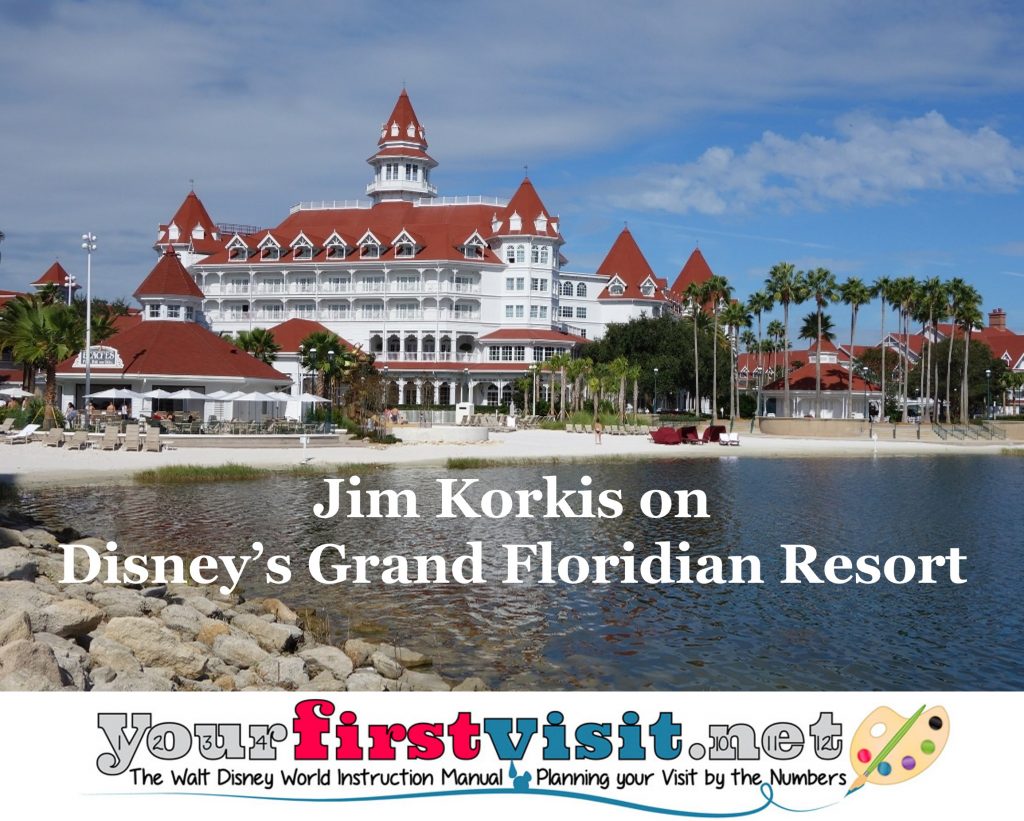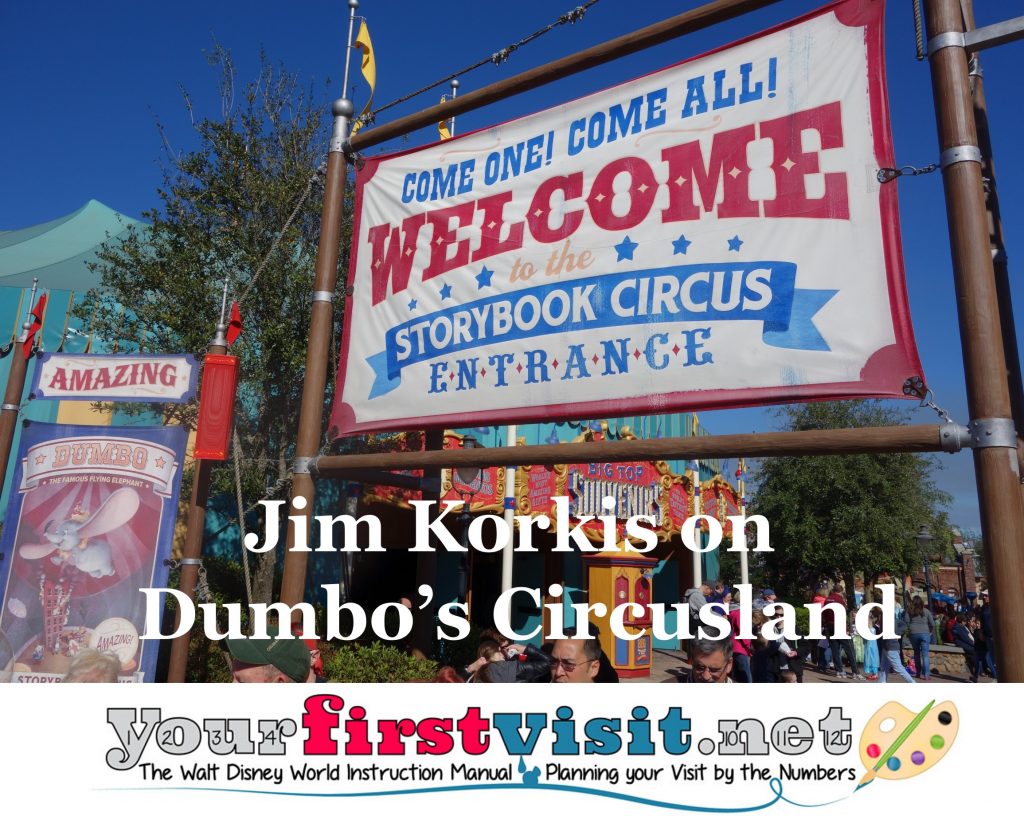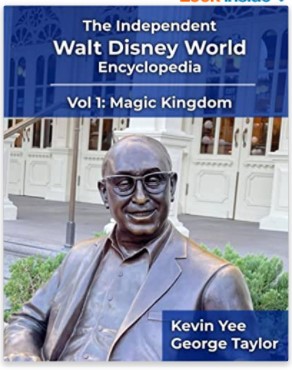Category — A Friday Visit with Jim Korkis
Fridays with Jim Korkis: Columbia Harbour House
Welcome back to Fridays with Jim Korkis! Jim, the dean of Disney historians, writes about Walt Disney World history every Friday on yourfirstvisit.net.
COLUMBIA HARBOUR HOUSE IN MAGIC KINGDOM
By Jim Korkis
The Columbia Harbour House is themed as a New England tavern of the Colonial time period. During the American Revolutionary War, the proprietor of the Harbour House was Harold Stalmaster while the innkeeper was a woman named Priscilla “Cilla” Lapham.
Around 2011, crates were added to Liberty Square addressed to different residents of the locale. Harold Stalmaster is a reference to actor Hal Stalmaster who portrayed in the role of Johnny Tremain in the 1957 Disney live action film Johnny Tremain based on the novel of Revolutionary War characters. Another crate is addressed to innkeeper Pricilla Lapham, who was Johnny’s love interest in the story.
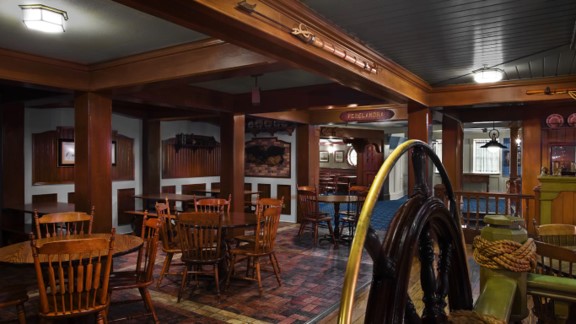
(c) Disney
Located between Fantasyland and Liberty Square, the counter service restaurant has two entrances. The Fantasyland side represents a dock in England (since it is just below the Peter Pan’s Flight attraction) set at a time when most people were illiterate, so the sign just features a chicken and fish to indicate what was served inside the restaurant, much like English pubs of the time would have images on signage to identify them.
The Liberty Square side represents a port in New England and the sign spells out the name with the British “u” included in “Harbour”. Instead of images of a chicken and fish, since this is a later time period in the New World when many people could read, it features the American bald eagle first designed in 1776.
Looking closely at the eagle, the thirteen arrows representing the original colonies are in its right claw signifying “war”. The back of today’s dollar bill has the arrows in its left claw, and an olive branch in the right one signifying “peace”.
Based on concept sketches by Imagineer Dorothea Redmond, The Harbour House didn’t open until Summer 1972, along with Olde World Antiques, the Perfume shop, and the Heritage House. In early planning and maps it was designated as the Nantucket Harbor House and even sometimes as New Bedford and Montauk Point.
By the time it opened, it was officially the Columbia Harbour House because there were plans for the Sailing Ship Columbia to ply the waters of the Rivers of America, like at Disneyland. In 1787, when the Constitution was ratified as is referenced in the number of the building that houses the Hall of Presidents, the Columbia became the first American sailing ship to circumnavigate the globe.
Columbia Harbour House is one of the largest restaurants at the Magic Kingdom, but seems more intimate with its low ceilings and small dining areas named after port towns: Charleston, Cape Hatteras, Chesapeake Bay, Annapolis, Long Island, Cape Cod, Portsmouth, New London, Newport, Marblehead, Salem and Plymouth.
One of the second floor rooms, by a window overlooking the Haunted Mansion, is themed to the paintings of ghost ships like The Flying Dutchman. There is also a map from the National Geographic magazine that is framed and marks the locations of 500 ships that were lost on the U.S. coastline between Virginia and North Carolina.
The Harbour House is decorated with nautical artwork and paraphernalia such as an antique scuba helmet, scrimshaw, mermaid figureheads from ships, model ships, nautical paintings, chandeliers made from helms, maps of the ocean, helms mounted on the walls, and charts, among other clever details. One of the paintings in the restaurant is a recreation of a painting from 20,000 Leagues Under the Sea (1954).
For the first two decades the restaurant was open there was second separate serving area upstairs with its own kitchen. In the 1990s this was closed and walled up.
* * * * *
Thanks, Jim! And come back next Friday for more from Jim Korkis!
In the meantime, check out his books, including his new books Vault of Walt: Volume 10: Final Edition, Kungaloosh! The Mythic Jungles of Walt Disney World and Hidden Treasures of Walt Disney World Resorts: Histories, Mysteries, and Theming, much of which was first published on this site.
Follow yourfirstvisit.net on Facebook or Twitter or Pinterest!!
March 11, 2022 No Comments
Fridays with Jim Korkis: Grand Floridian Fun Facts
Welcome back to Fridays with Jim Korkis! Jim, the dean of Disney historians, writes about Walt Disney World history every Friday on yourfirstvisit.net.
FUN FACTS ON DISNEY’S GRAND FLORIDIAN RESORT
By Jim Korkis
I recently wrote a book about the WDW resort hotels but I am always discovering new information so here are some fun facts that do not appear in that book.
The forty acre Grand Floridian Resort & Spa opened June 28, 1988 and the Walt Disney Company describes it as the “crown jewel of the Walt Disney World Resorts”. It is the most expensive of all the WDW resorts, not counting the new Star Cruiser Halycon, a different type of resort that is more akin to a Disney Cruise vacation.
The theming of the Grand Floridian inspired the design of both the Hong Kong Disneyland Hotel and the Disneyland Hotel in Paris.
The Beach Boys taped the music video for the 1988 song “Kokomo” on the sand of what originally was known as Disney’s Grand Floridian Beach Resort.
Cast members John (security investigator) and Heidi Pickert (senior sales manager) were the first couple to be married at Disney’s Wedding Pavilion on July 15, 1995.
The gallery located near the entrance of Victoria and Albert’s restaurant features eleven original maps of Florida from 1775 up to the period of railroad tycoon Henry M. Flager’s railway lines.
The two large chandeliers in the lobby are sixteen feet tall and fourteen feet wide at the base. Each weighs approximately one ton and has forty-four candelabras.
The resort received its first AAA Four Diamond award in 1990 and has continued to earn it every year since. Its Victoria and Albert’s is one of only five dozen Five Diamond restaurants in North America.
In 2007, nearly every room received an elegant makeover with new bedding, wallpaper and furnishings. In 2008, the resort installed a custom-designed marble floor throughout the main lobby and mezzanine. It includes “hidden” Disney characters like Pluto inlaid into it.
Several episodes of the Hulk Hogan television series, “Thunder in Paradise”, were filmed at the Grand Floridian.
On Monday and Friday mornings almost fifty housekeepers do what has been known as the parasol parade. They grab beautiful parasols and, starting at the swimming pool, they stroll through the pathways of the Victorian garden in the center courtyard. They often choose one or two children to lead the parade. It started in 1988.
On October 3, 2020, the Grand Floridian Society Orchestra that had entertained guests since the resort first opened thirty-two years earlier gave its final performance. A pianist could be found during the daytime hours playing popular Disney melodies on the grand piano in the center of the first floor lobby.
During the evening hours, The Grand Floridian Society Orchestra played tunes of ragtime, Dixie, traditional jazz and Disney favorites from the upper floor custom built bandstand. Originally, they played in the area now known as the Enchanted Rose, but when the lounge opened, they were moved to the upper floor lobby bandstand.
For many years, the Grand Floridian had its own exclusive line of bath products. These were branded with the name of the Grand Floridian on them, and had that fresh, elegant smell that seems to pervade the whole Victorian resort. Unfortunately for consistency and cost issues, the Grand Floridian’s bath amenities were changed to match the rest of the resort hotels on property.
The sheets on all beds are changed daily, unlike other WDW resorts. In addition, the beds are also triple-sheeted which gives them a lusher feel and makes them more comfortable. Standard beds have a bottom sheet, top sheet, and blanket. A triple-sheeted bed, however, has a third sheet on top of the blanket.
The December 2021 gingerbread house in the lobby celebrating WDW’s 50th anniversary with some blue and gold trim and official logo included1,050 pounds of Honey, 140 pints of Egg Whites, 600 pounds of Powdered Sugar, 700 pounds of Chocolate, 800 pounds of flour and 33 pounds of spices.
* * * * *
Thanks, Jim! There’s much more on the Grand Floridian beginning here. And come back next Friday for more from Jim Korkis!
In the meantime, check out his books, including his new books Vault of Walt: Volume 10: Final Edition, Kungaloosh! The Mythic Jungles of Walt Disney World and Hidden Treasures of Walt Disney World Resorts: Histories, Mysteries, and Theming, much of which was first published on this site.
Follow yourfirstvisit.net on Facebook or Twitter or Pinterest!!
March 5, 2022 No Comments
Fridays with Jim Korkis: Dumbo’s Circusland
Welcome back to Fridays with Jim Korkis! Jim, the dean of Disney historians, writes about Walt Disney World history every Friday on yourfirstvisit.net.
DUMBO’S CIRCUSLAND AT MAGIC KINGDOM
By Jim Korkis
When Storybook Circus opened at Walt Disney World in March 2012, the premise was that a traveling circus has just come to town like in the animated feature film Dumbo (1940), with all the bright colors and lively music. In the pavement, the circus animals have left behind their footprints, and the elephants even dropped a few peanut shells.
It just seemed natural to showcase Dumbo in a circus setting with a few attractions. However, the concept actually came from a proposed expansion of Disneyland’s Fantasyland in 1974 that would have opened in 1976.
Designed by Imagineer Tom Scherman, the new area would have been located approximately on five acres where Mickey’s Toontown was eventually situated. All the show buildings would be covered with striped circus tent awnings and the entire area would be filled with attraction posters and bunting to give the impression that a travelling circus had just arrived.
A clown themed restaurant would be the main eating location and feature carnival styled food offerings. A small merry-go-round for younger guests called Circus Parade would feature carved giraffes, lions and other circus animals to ride instead of horses.
The Dumbo spinner attraction would have been moved out of Fantasyland and relocated and set on an elevated platform to be the prominent centerpiece of the new land. The Casey Jr. Circus Train would also have been diverted to this new location.
Three new attractions would have been built including a Pinocchio dark ride attraction very similar to Pinocchio’s Daring Journey that was added to Disneyland’s Fantasyland in 1983. It would have had some differences as well including an additional scene in the queue waiting area called Stromboli’s Little Puppet Theater.
Disney Legend Ward Kimball was directly involved in the creation of the Mickey’s Mad House attraction that was meant to immerse guests into classic black-and-white Mickey Mouse cartoons. Outside the circular show building decorated with images of classic Mickey Mouse was a small water fountain with a tiny clown fireman somewhat resembling Kimball spluttering water from a fire hose.
Inside, the attraction would utilize the traditional amusement park Wild Mouse Coaster that would careen back and forth. It would be similar to the Primeval Whirl attraction at Disney’s Animal Kingdom but entirely enclosed in the dark so that guests would not be able to see clearly when it would veer back and forth or suddenly drop.
The premise was that guests were inside one of Mickey Mouse’s classic cartoons and the attraction would use film projections, simple audio-animatronics figures, real sets and plywood cut outs. Excerpts from five or six of Mickey’s cartoons would be utilized and brisk ragtime music would be played in the background to try to create a wild, “mad” atmosphere.
The third new attraction would be an elaborate “E Ticket” audio-animatronics show called Circus Disney that was somewhat reminiscent of the recently opened Mickey Mouse Revue in Walt Disney World but would carry guests on some type of track.
The attraction would feature not only characters from Dumbo, but other animal and fantasy characters that did not quite fit into other areas of the park. One section was devoted to the Wild Animal Menagerie which would feature Dumbo, Horace Horsecollar, and Elliot the dragon among others.
Guests would have been whisked through the Wild Animal Menagerie and then fly down the circus midway with Dumbo himself. In the finale, daredevil acts in a three-ring setting under the Big Top would feature the Flying Goofys and the Disney Bears Pyramid. There would even be a clown alley with Disney characters.
When the Walt Disney Company finances and other resources were shifted to building Epcot Center and Tokyo Disneyland, Dumbo’s Circusland quietly disappeared.
* * * * *
Thanks, Jim! And come back next Friday for more from Jim Korkis!
In the meantime, check out his books, including his new books Vault of Walt: Volume 10: Final Edition, Kungaloosh! The Mythic Jungles of Walt Disney World and Hidden Treasures of Walt Disney World Resorts: Histories, Mysteries, and Theming, much of which was first published on this site.
Follow yourfirstvisit.net on Facebook or Twitter or Pinterest!!
February 25, 2022 No Comments
Fridays with Jim Korkis: The Independent Walt Disney World Encyclopedia
Welcome back to Fridays with Jim Korkis! Jim, the dean of Disney historians, writes about Walt Disney World history every Friday on yourfirstvisit.net.
YOUR PERSONAL DISNEY LIBRARY (49)
By Jim Korkis
- The Independent Walt Disney World Encyclopedia Vol. 1: Magic Kingdom by Kevin Yee and George Taylor
Knowing the experience and previous work of the two authors of this book, Kevin Yee (whose past books, including Walt Disney World Hidden History, I have recommended) and George Taylor (whose original ImagiNerding website was a favorite of mine and I told him so), and their reported list of sources that they used, I was personally extremely disappointed with this book.
It is described as follows: “This volume about the Magic Kingdom is the first in a series of comprehensive books about the Walt Disney World parks and resorts. The authors combed through numerous official sources such as park guide maps, official books, the official Walt Disney World website, and D23 publications and blogs to collate their information, and cross-referenced it thoroughly with unofficial sources, like third-party books and guides, fan websites, news websites, and fan blogs and podcasts. The result is a first-ever comprehensive listing of attractions, restaurants, and merchandise locations in the Magic Kingdom.”
It is oddly sized at eight by ten inches and contains only a hundred and three pages of content, with an additional twenty pages being lists of attractions/restaurants/shops by Land and an index. It also includes small black-and-white photos scattered throughout the text.
It is definitely not “comprehensive”. The short paragraph entries in the body of the book are cursory at best, and incomplete and misleading at worst.
For instance, the description of the Sword in the Stone ceremony held in Fantasyland lists the opening date but omits that it ended in August 2006. I would have also liked an additional sentence at least to explain that Merlin was looking for the new “temporary ruler of Fantasyland” while King Arthur was on vacation, and that the show ran approximately fifteen minutes. This information and more is easily obtainable and confirmed with a few seconds of searching.
Entries are not just incomplete but often misleading. The entry for the Diamond Horseshoe Revue indicates that it was replaced in 1986 by the Diamond Horseshoe Jamboree and “the show remained relatively the same”. No, it was a completely different show with Miss Lily and Sam the Bartender now hosting with completely different music, only a piano accompanist and some on-stage audience participation, among other things.
Once again, this information is not obscure or difficult to find quickly. Many items are just simply missing as well, including the Citizens of Main Street like the Mayor who made many magical memories for guests over the years, or the Car Barn in Town Square where guests could visit one of the horses, discover the authentic antiques and chat with a cast member. There is no entry for the Partners or Sharing the Magic statues even though they use the image of the Roy statue on the cover and list a Partners reference in the index that leads to a page with no information on it.
Sometimes you already need to know something like that Beacon Joe is on the Rivers of America (he is not listed in the index) just to find the name but no explanation of who or what he is in the Rivers of America description.
Sadly, both of these authors know much more about the Magic Kingdom off the top of their heads as they have demonstrated than they have included in this book.
My standard for what a Disney park Encyclopedia should look like is The Disneyland Encyclopedia by Chris Strodder that I highly recommend. It is accurate, clear and filled to overflowing with information, especially opening and closing dates.
At this point, I am not looking forward to future volumes of this series from Yee and Taylor, but at a cost of only eight dollars you may consider it worth adding to your collection if you are a completist.
* * * * *
Thanks, Jim! Come back next Friday for more from Jim Korkis!
In the meantime, check out his books, including his new books Vault of Walt: Volume 10: Final Edition, Kungaloosh! The Mythic Jungles of Walt Disney World and Hidden Treasures of Walt Disney World Resorts: Histories, Mysteries, and Theming, much of which was first published on this site.
Follow yourfirstvisit.net on Facebook or Twitter or Pinterest!!
February 18, 2022 No Comments
Fridays with Jim Korkis: The Liberty Bell Replica at Magic Kingdom
Welcome back to Fridays with Jim Korkis! Jim, the dean of Disney historians, writes about Walt Disney World history every Friday on yourfirstvisit.net.
THE LIBERTY BELL AT MAGIC KINGDOM
By Jim Korkis
Several myths surround the Liberty Bell that sits in Magic Kingdom’s Liberty Square. First, it is supposedly one of fifty replicas that were cast in 1976 to celebrate the United States’ 200th birthday with a copy given to each of the states. Second, supposedly Pennsylvania already had the original, so their copy was given to Walt Disney World to display.
Fifty replicas were indeed cast, but in 1950 as a way to promote the sales of U.S. Treasury Bonds. Moreover, Pennsylvania’s replica is at the Zion’s United Church of Christ in Allentown, Pennsylvania. The reason is that the church in 1777 hid the original Liberty Bell from the British who intended to melt it down for tools of war.
So what is the real story behind Walt Disney World’s Liberty Bell?
Cemetery owner Foy Bryant of Fair Oaks, California purchased a Liberty Bell replica bell in 1975 from the Paccard Bell Foundry in Annecy, France, where the 1950 U.S. Treasury replicas were cast. He would take the bell to schools for children to experience and it was also prominent at celebrations like parades in Sacramento throughout the year.
With the celebration of the bicentennial of the U.S. Constitution in 1987, he decided it needed a more prominent display where millions of people could see it.
On Friday, September 11th, 1987, a forklift slowly lifted the 12-year-old replica onto the back of a flatbed truck for its 2,827-mile cross-country journey, arriving at Walt Disney World the next Monday. Bryant and Disney had arranged for a one-year loan.
On September 17th, 1987, a cast member dressed as Ben Franklin joined Mickey Mouse in a powdered wig and Minnie Mouse in a ruffled skirt as they paraded down the street in Liberty Square.
When they stopped at the newly-arrived Liberty Bell at precisely four o’clock, Mickey grasped a rope tied to the bell’s clapper and proceeded to ring the Liberty Bell for 200 seconds straight as about 500 onlookers waved tiny American flags. They were taking part in a nationwide ringing of the bells event to kick off Constitution week.
The following month, Walt Disney World launched the Star-Spangled Salute, which included a daily parade down Main Street U.S.A. The All America Parade ran from 11/87 to 11/88, when it morphed into Mickey’s All American Birthday Parade with the same floats but a new theme song from 11/88 – 11/89.
The inaugural celebration featured Astronaut Gordon Cooper and Roots author Alex Haley officially unveiling Disney’s borrowed Liberty Bell.
The bell proved to be such a popular attraction that its stay was extended through June of 1989. While they were still borrowing the Mount Vernon bell, Walt Disney World was planning to make a Liberty Bell a permanent fixture.
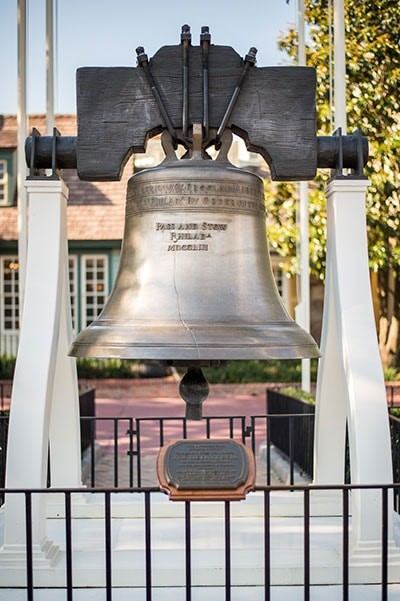
(c) Disney
Disney Show Properties and Interiors ordered their own Liberty Bell Replica from the Paccard foundry cast from the same mold as the original Liberty Bell. Whether by advance planning, luck or creative accounting, the bell was declared the 300th replica produced by the famous foundry. Fifth-generation bellmaster Pierre Pacard was pictured in the papers, diapason in hand, personally tuning the bell to strike an E-flat note.
The Liberty Square bell stands eight feet tall, weighs two and a half tons, and is cast from a mix of copper, tin, lead, zinc, arsenic, gold and silver. It was hoisted into its present location by a crane just in time for the 1989 Independence Day Celebration, where it was surrounded by thirteen flags representing the original colonies with plaques indicating when that state ratified the Constitution.
Foy Bryant’s bell made it back to California and was installed in Mount Vernon’s Court of Liberty.
The Liberty Bell replica at Walt Disney World in Orlando, Florida, is both the world’s most visited Liberty Bell and the world’s most expensive to visit. In 2018, 40 million park guests walked right past Disney’s Liberty Bell and that is ten times the number that visited the Liberty Bell in Philadelphia that year.
Florida’s official replica is in the state Capitol of Tallahassee. A museum in Melbourne and a cemetery in Gotha also have one.
* * * * *
Thanks, Jim! And come back next Friday for more from Jim Korkis!
In the meantime, check out his books, including his new books Vault of Walt: Volume 10: Final Edition, Kungaloosh! The Mythic Jungles of Walt Disney World and Hidden Treasures of Walt Disney World Resorts: Histories, Mysteries, and Theming, much of which was first published on this site.
Follow yourfirstvisit.net on Facebook or Twitter or Pinterest!!
February 11, 2022 No Comments
Fridays with Jim Korkis: Liberty Tree Tavern
Welcome back to Fridays with Jim Korkis! Jim, the dean of Disney historians, writes about Walt Disney World history every Friday on yourfirstvisit.net.
LIBERTY TREE TAVERN IN LIBERTY SQUARE AT MAGIC KINGDOM
By Jim Korkis
Liberty Square is a land that exists only at Walt Disney World’s Magic Kingdom. Its existence was influenced not only by Walt Disney’s desire for a similar location at Disneyland to celebrate the founding of America, but also that in just a few years after Walt Disney World’s opening there would be a huge Bicentennial celebration.
As early as 1969, the Annual Report for Walt Disney Productions stated that “Liberty Square will offer relaxed dining in an early American restaurant featuring a series of small picturesque rooms reminiscent of colonial times.”
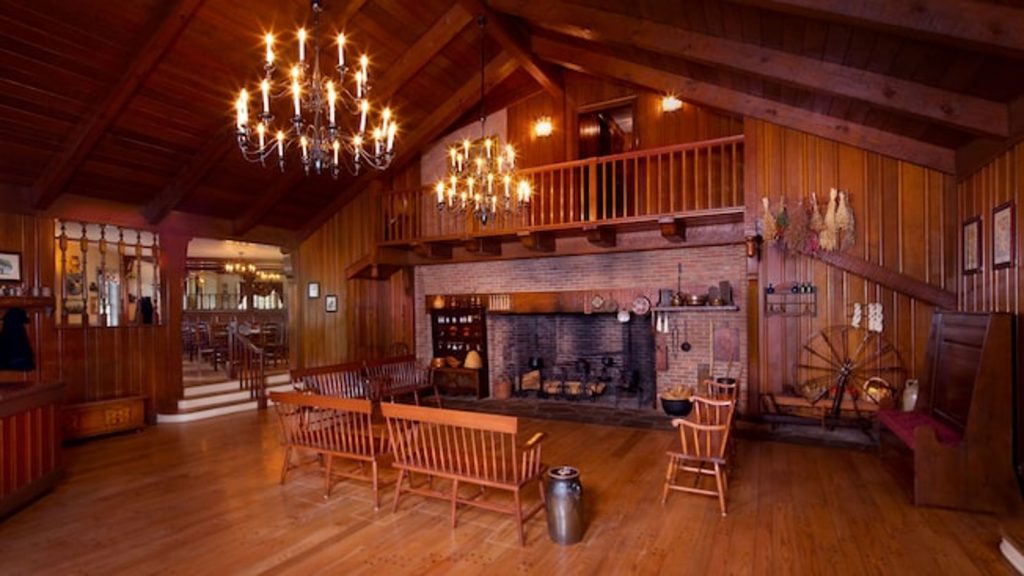
(c) Disney
This restaurant was eventually named the Liberty Tree Tavern to reference the massive Liberty Tree that was growing just outside the restaurant. The structure resembled an eighteenth century colonial home, and served New England style fare served by the Sons and Daughters of Liberty attired in appropriate costumes.
The food is appropriately named to maintain the theme including the Patriot’s Platter which is like having Thanksgiving every day of the year, the Declaration Salad, Johnny Appleseed’s Warm Apple Cake, and more.
The interior prominently displays wood planking, with the creaking floorboards and stairs adding to the authenticity. Rich wood paneling, candelabra chandeliers, lanterns, iron kettles and pots, vintage butter churn, baskets, pewter glasses and more artifacts emphasize the time period. Some windows are done in wavy “seed” glass that was common during that time.
When Liberty Tree Tavern opened in October 1971, the menu proclaimed, “Welcome to the early days of colonial America re-created throughout Liberty Square. Here in the Liberty Tree Tavern and throughout Liberty Square our proud heritage comes alive before your eyes.
“Within the Liberty Tree Tavern, you can see many original works of art created for the Hall of Presidents. Most of the historical scenes displayed here depict the Whiskey Rebellion of 1794, an insurrection in Western Pennsylvania against a high tax on surplus corn. Painted on aged redwood, each scene represents hours of concentrated study re-enacting the early days of colonial America.”
Over the decades, the restaurant has undergone several renovations, so some of the original items are no longer displayed. Until 2008, a “town crier” would call out each dining party’s last name and home state when their table was ready. Character dining took place in Liberty Tree Tavern from the early 1990s to 2009.
A refurbishment in the early 1990s resulted in the interior being divided into six dining rooms, with each one dedicated to a Revolutionary-era hero: George and Martha Washington, Thomas Jefferson, Paul Revere, Benjamin Franklin, Betsy Ross, and John Paul Jones. Each dining room includes its own fireplace, a name plaque and portrait of the historical figure, and items associated with that person.
In the Benjamin Franklin room is a First Edition of his Poor Richard’s Almanack, and a kite and keys referencing his famous experiment with electricity.
John Paul Jones’ room has a nautical feel with model ships and navigation equipment like a brass compass and vintage maps. A framed advertisement urges men to sign up to join the crew of the ship Ranger captained by Jones.
The Thomas Jefferson room displays numerous books, documents, paintings of his home Monticello and, of course, a quill and ink well since Jefferson penned the Declaration of Independence.
The Paul Revere room includes a variety of silver plates, cups and dishes to reference Revere’s occupation as a silversmith.
The Betsy Ross room has a colonial flag with thirteen stars in a circle as well as sewing items. The George and Martha Washington room includes George’s wooden teeth and his tri-cornered hat by the door.
In order to keep things authentic, Imagineers balked at including restrooms but legally needed to include them, so they put small ones upstairs, way in the back, so that Walt Disney World can claim they are not physically in Liberty Square. They have copper sinks and framed mirrors, and the doors are decorated with images of a colonial gentleman and woman.
* * * * *
Thanks, Jim! Liberty Tree Tavern has a special place in my life, as it is where I met Josh of easyWDW for the first time, long ago.
And come back next Friday for more from Jim Korkis!
In the meantime, check out his books, including his new books Vault of Walt: Volume 10: Final Edition, Kungaloosh! The Mythic Jungles of Walt Disney World and Hidden Treasures of Walt Disney World Resorts: Histories, Mysteries, and Theming, much of which was first published on this site.
Follow yourfirstvisit.net on Facebook or Twitter or Pinterest!!
February 4, 2022 No Comments


